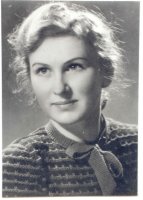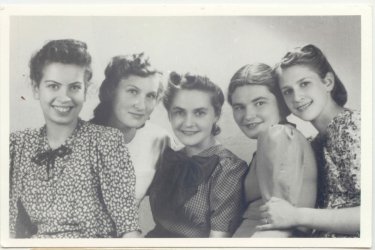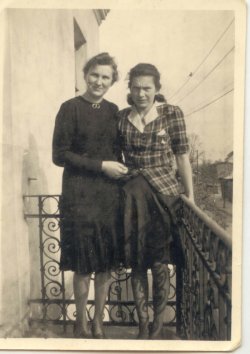
Barbara Gancarczyk-Piotrowska,
born on the 18th of October 1923 in Warsaw
the nurse of the Home Army
pseud. "Pajak" (=spider)
the 2nd platoon of the assault company
Scouts' battalion of the Home Army "Wigry"
Insurgent accounts of the witnesses
War Reminiscences of the nurse of the Scouts' battalion of the Home Army "Wigry" Barbara Gancarczyk-Piotrowska pseud. "Pajak" (=Spider)
Occupation
Our existence during the occupation was not easy. My father took up odd jobs. He worked as an housing estate administrator, received registration. He did also other off-and-on work. As a sixteen-year-old girl I tried to help my parents. I gave private lessons, made drawings, knitted. I recall that my knitting went to the shop on Mokotowska Street. I got the wool from unstitched sweaters.
The Germans closed secondary schools and tertiary-level ones. The girls could study at sewing schools, business schools and home economics schools. For boys, there were vocational colleges of building and a craftsman's workshops. Officially, only such schools existed.
Pre-war teachers did not give up and they began to organise secret education. In schools whose buildings survived, classes at the secondary school level were conducted under the cover of vocational schools. It was the same in case of the Sisters of the Holy Family of Nazareth school, where officially a sewing school was located.
The building of the Maria Konopnicka grammar school, to which I passed the entrance exams in summer 1939, located on Barbara Street, was destroyed. In these circumstances the education was organised within the frames of secret classes. Groups made of 5 girls each were created for the secret classes. The classes were held everyday in private lodgings. The meeting places were changed because of the conspirational matters. Our poor teachers who had several secret classes a day, ran from one corner of Warsaw to another, to be on time. They were never late, you could always count on them. There were all school subjects which were taught before the war: Polish, French, Mathematics, Physics. Even the priest came for a religious instruction class.
Some still had pre-war textbooks, apart from these, we learnt from our notes, and most of all, directly from the lectures by our teachers. We were given homework, we solved mathematical problems. On my secret classes there was a wonderful mathematician Ms. Straszynska, thanks to whom I had no problem with passing the entrance exam to the university.
The secret classes were free. It seems to me that the teachers got their salaries from the Department of Education and Culture of the Underground State. These salaries were rather very meagre.
I took the Matura exam (= high school finals) in 1941 at school which officially existed as a vocational one. It was located on Bagatela Street. There, on the exam's day, they had gathered in the room probably twenty of us girls. I remember how we were given the exam's topics. During the Polish exam, I had the topic "Warsaw in the eyes of Boleslaw Prus." The second written exam was the Mathematics exam which took place in the same building. Then there were oral exams, Polish, History and Mathematics exams as far as I remember. A large group of girls took the Matura exam.

The secret classes Matura graduates in 1941 Second on the left: Barbara Piotrowska
We took our education very seriously. It was the struggle against the occupant in some sense. The secret classes did not protect us from round-ups. We had no identity cards in recognition of the fact that we were learning. The girls who learnt at the vocational school or worked at the same time had identity cards and felt more secure. Because of it, each of us had other things to do apart from learning. During the time when I was a student of the grammar school, I also worked in the information point of the Polish Red Cross which was located where Ateneum Theatre is today, on Czerwonego Krzyza Street. This work provided me with an identity card and protected me to some extend. I went to the PRC in the afternoon for two hours. I lived on Saska Kepa, the office was located on Czerwonego Krzyza Street on the other side of the Vistula, so it was not far from my home. I had a "good" PRC identity card.
After passing the Matura exam, in September 1941 I enrolled on the Jagodzinski Technical Drawing Course, this is how the technical school was officially called. It was one of the "cover-ups" which in fact organised secret classes on the university level. There was the Building Department, the Mechanic Department and the Electrical Department , if I remember well. I was accepted to the Building Department. The school was located on the Sniadeckich Street, in a pre-war school building. The classes took place in the afternoon, and the lecturers were the professors of the Warsaw University of Technology. The quality was very high. The Germans were not aware what kind of classes took place in this school.
The Mathematics lectures were conducted by Professor Witold Pogorzelski, the Warsaw University of Technology professor, a famous mathematician who was aided by his assistants. Descriptive Geometry was taught by Edward Otto who received the professorial appointment at the University of Technology after the war. The world-famous Professor Stefan Bryla lectured on Reinforced Concrete and Steel Construction. Professor Trzcinski, a pre-war professor, taught Architecture. The First Degree Freehand Drawing - Professor Kaminski from the Architecture Department, Design - pre-war Professor Aleksander Bojemski.
Marian Lalewicz, an eminent professor of the pre-war Architecture Department, lectured on the History of Middle-Age and Ancient Architecture, Jan Zachwatowicz and his assistants - on the History of Polish Architecture, Professor Lech Niemojewski - the History of Modern Architecture. These lecturers ensured the high quality of education.
Part of the lectures were conducted at the official school during the so-called technical drawing courses, and the rest of the subjects was taught on the secret classes. We had the lectures in the Architecture building on Koszykowa Street. Part of the building in front where you got from the side of Koszykowa Street, was occupied by the Building School. People taking part in secret classes were admitted from the back of Architecture Department. You went there from the backyard on Lwowska Street.
The kind-hearted, pre-war janitor Mr Wiraszko was always on the look-out by the door. He let us in to the rooms of Polish Architecture Department from the side of the backyard. There, the lectures took place: History of Art, History of Architecture illustrated with slides. Of course, we made some additional drawing exercises and so on.
The classes were also conducted in town, in the students' and even professors' lodgings. My History of the Ancient and Middle-Age Architecture exam took place in the private lodgings of Professor Marian Lalewicz, I took the Reinforced Concrete exam in the private lodgings of Professor Bryla, who lived on 10 Noakowskiego Street, and before the war he was the dean of Architecture Department. During the occupation, Professor Bryla was the co-organiser of the Secret University of Technology.
The requirements at the studies were very high. I remember the exam with Professor Lalewicz. Four of us took this exam: me, two women and one man. We were studying very thoroughly for this exam. The subject was extremely interesting and beautifully taught. After the exam the professor said: "You know, before the war I have never had such well-prepared students." And he gave us all As.
The grades were written down on pieces of paper which were later handed over to a friend. The results of the exams which we took officially at Jagodzinski school, were noted down in our pseudo-student's books. The student's books were simply a three-page piece of cardboard where the grades in individual subjects were written down. The grades from the exams taken on the secret classes were put down on pieces of paper and later on noted down by a friend who archived them.
As I have already mentioned, I began my studies in September 1941. During the last year of study, 1944, the youth was very strongly engaged in additional jobs, most of all in the underground movement. Because of it, there were breaks in the studies. I took the last exam in, I do not remember very well, perhaps in 1943.

The Piotrowski Sisters: Barbara and Elzbieta in 1943
Professor Bryla, who was the co-organiser of the Warsaw University of Technology, extremely cared for the fact that the youth should study. He told us repeatedly: "Study, do not neglect your education. What you do now, you will be given a credit for after the war." The professor was quite stiff, sometimes he could scold someone off, but the scolding was always deserved. In addition, he was a man of great courage and sacrifice, totally devoted to young people.
During the occupation, all the time a strong sense of danger existed. Most of all, there was terror from the very beginning. There were mass murders, arrests, executions in Palmiry as soon as 1940. There were round-ups from the houses, the Germans surrounded entire city quarters. By us on Kepa there was such a day, Sunday, when they surrounded entire street complexes, went from house to house and caught innocent people from their houses. Later some of them were executed, some went to concentration camps, others to labour camps.
I lived on Kepa and I crossed the Poniatowski Bridge everyday. It often happened that the Germans stopped the tram on the bridge, one could not escape anywhere but to Vistula. God forbid if they found something, some suspicious packet, because one carried various things, newspapers or even weapons sometimes. Then all people automatically went to prison, to be executed. There was a curfew, in winter it was 8 or 7 p.m. When I returned home a few minutes after the curfew, my mum trembled with fear that something might have happened.
Barbara Gancarczyk-Piotrowska
prepared by Maciej Janaszek-Seydlitz
translated by Katarzyna Wiktoria Klag
Copyright © 2012 Maciej Janaszek-Seydlitz. All rights reserved.